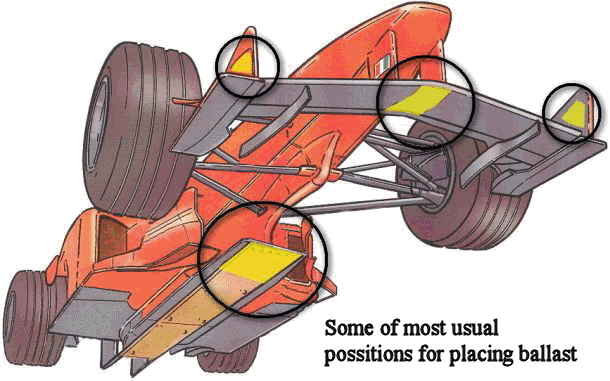Formula 1 is a sport where every centimeter counts. The difference between winning and losing can be a matter of millimeters, or even microseconds.
But what about the f1 driver heights? Does being taller or shorter give you an edge or a disadvantage in the fastest and most competitive racing series in the world?
In this article, we will explore how f1 driver heights affects the performance, challenges and achievements of F1 drivers, and how they cope with the physical and mental demands of their profession.
F1 Driver Heights – The Tallest Driver

The tallest driver to race in F1 this millennium is Justin Wilson, who stood at 193cm (almost six foot, four inches).
Wilson competed in 16 races for Minardi and Jaguar in 2003, scoring one point at the US Grand Prix. He was 7cm taller than any other driver to race in F1 since 2000.
Wilson faced some difficulties due to his height, such as fitting comfortably in the cockpit and meeting the minimum weight limit.
He had to lose weight and use a specially designed seat to accommodate his long legs. He also had a disadvantage in terms of aerodynamics, as his head created more drag than shorter drivers.
Wilson’s F1 career was cut short by a lack of sponsorship and opportunities, but he went on to have a successful career in IndyCar, where he won four races and finished sixth in the championship in 2013.
Sadly, he died in 2015 after being hit by debris from a crashed car at Pocono Raceway.
The Next Group Of Tall Drivers
The next group of tallest drivers are all 186cm (six foot, one inch) tall. They are Alexander Albon, Alexander Rossi, Alexander Wurz and Esteban Ocon.

Albon raced for Toro Rosso and Red Bull between 2019 and 2020, scoring two podiums and finishing seventh in the championship in 2020. He lost his seat to Sergio Perez for 2021, but returned to F1 with Williams in 2022.
Rossi made five appearances for Marussia in 2015, with a best result of 12th at the US Grand Prix. He then moved to IndyCar, where he won the 2016 Indianapolis 500 as a rookie and finished second in the championship in 2018.
Wurz raced for Benetton, McLaren and Williams between 1997 and 2007, scoring three podiums and a best championship position of eighth in 2007. He also won the Le Mans 24 Hours twice, in 1996 and 2009.
Ocon is currently racing for Alpine, having previously driven for Manor and Force India/Racing Point. He scored his maiden F1 victory at the Hungarian Grand Prix in 2021, becoming the first French driver to win a race since Olivier Panis in 1996.

Other tall drivers who have raced in F1 since 2000 include George Russell, Nicholas Latifi, Nico Hulkenberg, Robert Kubica and Mark Webber, who are all 184cm (six feet) tall.
| Driver | Height |
|---|---|
| Justin Wilson | 193cm |
| Alexander Albon | 186cm |
| Alexander Rossi | 186cm |
| Alexander Wurz | 186cm |
| Esteban Ocon | 186cm |
| Andre Lotterer | 185cm |
| Antonio Giovinazzi | 185cm |
| George Russell | 185cm |
| Nicholas Latifi | 185cm |
| Paul di Resta | 185cm |
F1 Driver Heights – The Shortest Drivers
The shortest driver to race in F1 this millennium is Yuki Tsunoda, who is 159cm (five foot, two inches) tall. Tsunoda made his debut with AlphaTauri in 2021, scoring points on his first race in Bahrain.
He is also the first Japanese driver to race in F1 since Kamui Kobayashi in 2014.
Tsunoda’s height gives him some advantages over taller drivers, such as having less weight to carry around and being more aerodynamically efficient. However, he also faces some challenges, such as adjusting the pedals and steering wheel to suit his reach and visibility.

The next shortest driver is Anthony Davidson, who is 163cm (five foot, four inches) tall. Davidson raced for Minardi and Super Aguri between 2002 and 2008, scoring one point at the Belgian Grand Prix in 2007. He also won the World Endurance Championship with Toyota in 2014.
Other short drivers who have raced in F1 since 2000 include
- Takuma Sato
- Lando Norris
- Felipe Massa
- Fernando Alonso
who are all 171cm (five foot, seven inches) tall.
| Driver | Height |
|---|---|
| Yuki Tsunoda | 159cm |
| Anthony Davidson | 163cm |
| Takuma Sato | 164cm |
| Cristiano da Matta | 165cm |
| Allan McNish | 165cm |
| Giorgio Pantano | 166cm |
| Felipe Massa | 166cm |
| Nick Heidfeld | 167cm |
| Johnny Herbert | 167cm |
| Jarno Trulli | 167cm |
Do Smaller F1 Drivers Have An Advantage?
The cars are required to meet a specific weight irrespective of the drivers weight. Smaller drivers who weigh less are required to carry ballast in the car to increase the gross weight to the required limits.

The advantage shorter drivers have is that the ballast they carry to reach the minimum weight limit can be placed in an optimal position on the car.
That means on the floor, and either forward or rearward as the car’s set-up requires.
The advantage that this has presented teams has differed over the years depending on how difficult teams have found it to hit the minimum weight limit.
For example when the KERS hybrid boost was introduced in 2009 some teams could only justify the weight penalty of running it for their lighter drivers.
At BMW, for example, the heavier Robert Kubica had to make do without KERS but team mate Nick Heidfeld had it.
In other seasons hitting the minimum weight limit was been difficult. In these instances heavier drivers have raced without drinks bottles to save weight. .
F1 Driver Heights – Does Height Matter In F1
The answer is not straightforward, as there are many other factors that influence a driver’s performance, such as
- Talent
- Experience
- Car
- Team
- Strategy
- Luck.
However, we can try to compare the achievements of the tallest and shortest drivers in F1 history.
The tallest driver to ever win a world championship is Juan Manuel Fangio, who was 180cm (five foot, eleven inches) tall. Fangio won five titles between 1951 and 1957, a record that stood until Michael Schumacher surpassed it in 2003.
The shortest driver to ever win a world championship is Nino Farina, who was 165cm (five foot, five inches) tall. Farina won the inaugural F1 championship in 1950, driving for Alfa Romeo.
What Is The Average Height Of F1 World Champions?
The average height of the 33 F1 world champions is 176cm (five foot, nine inches), which is slightly below the global average for men.
The most common height among F1 champions is 175cm (five foot, nine inches), shared by seven drivers:

- Alberto Ascari
- Jack Brabham
- Jackie Stewart
- Niki Lauda
- Nelson Piquet
- Ayrton Senna
- Damon Hill.
The current F1 grid has a wide range of heights, from Tsunoda’s 159cm to Ocon’s 186cm.
The Average Height Of F1 Drivers
The average height of the 20 drivers in 2021was 177cm (five foot, ten inches), which is slightly above the global average for men.
Conclusion
Height is not a decisive factor in F1 success, as there have been champions and winners from both ends of the spectrum.
However, height does pose some challenges and advantages for drivers, depending on their car and team. Ultimately, it is the skill and determination of the driver that matters most in F1.

